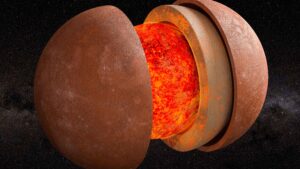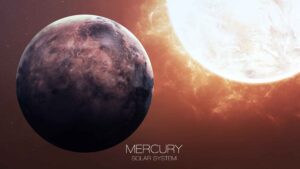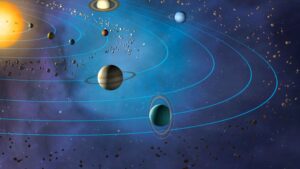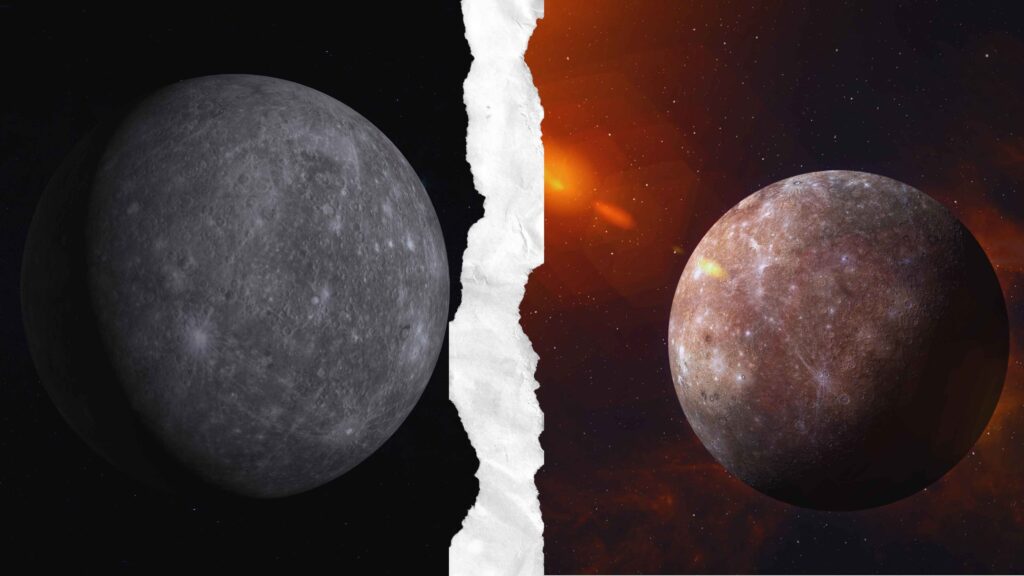Mercury is the planet nearest the Sun. Mercury is also the smallest planet in the solar system. Although it is close to the Sun, it is not the hottest planet. That might sound weird, but it is a fact. Mercury is a rock planet with no water, no oxygen to breathe, and no life. Yet, it is a very fascinating planet to study.
Mercury orbits the Sun quicker than any other planet. It has only 88 Earth days to make one circuit. This is the reason that Mercury is called after a fast Roman god. Speed and distance are very critical in space, and Mercury crosses the line to the Sun ahead every time.
How was Mercury created?
As with the other planets in our solar system, Mercury formed around 4.5 billion years ago. The solar system was then full of dust, rocks, and gases. Over time, tiny bits of rock glued together to form larger rocks. The larger rocks formed planets. Mercury was one of them.
Mercury consists primarily of metal and rock. It contains a very large iron core within it. Scientists think that a long time ago, Mercury was struck by a big object from space. This collision might have stripped away some of its outer layers, making it smaller and denser.
The top schools of Mohali and Kharar educate students about how our solar system was created. The study of planets such as Mercury aids children in gaining knowledge about space history.
You may also like: “Mars: The Red Planet’s Formation, and Possibility of Life”
What Is the Surface of Mercury Like?

Mercury’s surface resembles our Moon a great deal. It is covered with holes known as craters. These craters were formed when space rocks collided with the planet. Mercury has no weather, so these craters have not altered much over millions of years. They remain the same for millions of years.
Apart from craters, Mercury also consists of flat plains, high cliffs, and lots of rocky ground. Some of the cliffs are extremely long and tall. They were formed when Mercury cooled off and contracted slightly. When it contracted, the outside layer cracked and created huge cliffs.
Mercury is gray in color. It is not brightly colored like Earth. Mercury does not contain trees, lakes, or animals. Mercury is dry, dusty, and very silent.
Does Mercury Have an Atmosphere?
An atmosphere is a shell of air surrounding a planet. Earth boasts a dense atmosphere that enables us to breathe, as well as keeps the planet warm. Mercury lacks a proper atmosphere. It possesses only a thin shell of gases in “exosphere.”
The exosphere consists of small quantities of oxygen, sodium, hydrogen, and helium. These are extremely light gases that do not remain near the surface for long. Since Mercury lacks a dense atmosphere, it is unable to retain heat or shield sunlight.
This is the reason Mercury gets extremely hot in the daytime and extremely cold in the nighttime. Its thin atmosphere is not able to shield it from the heat or warm it in the darkness.
Temperatures on Mercury

Mercury experiences some of the solar system’s most extreme temperatures. When the Sun shines on it during the day, Mercury gets extremely hot. The temperature reaches as high as 430°C (800°F). That is hot enough to melt certain metals!
But at night, when the Sun has disappeared, Mercury gets extremely cold. The temperature drops as low as -180°C (-290°F). That is colder than the planet’s coldest place on Earth.
These huge alterations occur due to Mercury’s tenuous exosphere being unable to retain heat from the Sun. The planet warms rapidly but quickly loses heat as well.
Mercury’s Magnetic Field
Although Mercury is tiny, it does possess a magnetic field. A magnetic field is an imperceptible force that shields a planet from harmful space rays. Earth also possesses a magnetic field that shields us from space weather.
Mercury’s magnetic field is not as powerful as Earth’s but is still interesting. Scientists say that the magnetic field is a result of the iron core within Mercury, which is still partially liquid. The core rotates and creates a weak magnetic field surrounding the planet.
Studying magnetic fields teaches students about the way planets function. That is why top schools in Kharar and Mohali, such as Anee’s School, educate children on these interesting science subjects in an easy and interesting manner.
Has Mercury Been Visited?
Mercury is extremely difficult to visit. It is near the Sun, and the heat prevents spacecraft from reaching it. Scientists have sent a few missions to observe Mercury from space, though.
The first mission that flew by Mercury was named Mariner 10. This took place in 1974. Afterwards, NASA launched another mission named MESSENGER. It arrived at Mercury in 2011 and remained there for four years. MESSENGER snapped a lot of photographs and examined Mercury’s surface, atmosphere, and magnetic field.
In 2018, the new mission of BepiColombo was initiated by Europe and Japan. It is continuing on its route to Mercury and will provide more information in the future.
Fun Facts About Mercury

The following are some simple and fun facts about Mercury:
🚀 Mercury is the solar system’s fastest planet.
🚀 A Mercury day is longer than a year! One day (sunrise to sunrise) is 176 Earth days.
🚀 Mercury does not have any moons or rings.
🚀 Although it is the closest planet to the Sun, Venus is hotter because Venus has a very thick atmosphere.
Why Should Children Study Mercury
Mercury is a significant component of our solar system. By studying Mercury, students can learn about how planets are formed and how they function. They learn science, space, and incredible things that occur distant from Earth.
Science classes on planets make children smarter, curious to ask questions, and enthusiastic towards learning. Science schools with hand-on education keep these subjects straightforward and exciting. Top schools of Mohali and Kharar, such as Anee’s School, offer students wonderful exposure to space studying with enjoyable exercises, projects, and space models.
Conclusion

Mercury is a tiny but wonderful planet. It is the nearest planet to the Sun and the quickest one as well. It has a rocky surface, a thin atmosphere of gas, and extremely hot and cold temperatures. Although it does not have water or life, it shows us a great deal about how planets are created and how they evolve.
Children who are interested in space and planets will love studying Mercury. With the assistance of the top schools in Mohali and Kharar, students can study the solar system and grow up to be scientists, astronauts, or teachers. Space is full of magic, and Mercury is only the start of the journey!








